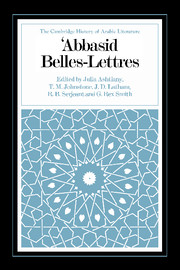Book contents
- Frontmatter
- The ʿAbbasid Caliphate: a historical introduction
- 1 Adab and the concept of belles-lettres
- 2 Shuʿūbiyyah in Arabic literature
- 3 Ibn al-Muqaffaʿ and early ʿAbbasid prose
- 4 Al-Jāḥiẓ
- 5 Al-Ṣaḥib Ibn ʿAbbād
- 6 Abū Ḥayyān al-Tawḥīdī
- 7 Al-Hamadhānī, al-Ḥarīrī and the maqāmāt genre
- 8 Fables and legends
- 9 ʿAbbasid poetry and its antecedents
- 10 Hunting poetry (ṭardiyjāt)
- 11 Political poetry
- 12 Love poetry (ghazal)
- 13 Wine poetry (khamriyyāt)
- 14 Mystical poetry
- 15 Ascetic poetry (zuhdiyyāt)
- 16 Bashshār b. Burd, Abū ʾl-ʿAtāhiyah and Abū Nuwās
- 17 Al-Mutanabbī
- 18 Abū Firās al-Ḥamdānī
- 19 Abū ʾl-ʿAlāʾ al-Maʿarrī
- 20 Literary criticism
- 21 Ibn al-Muʿtazz and Kitāb al-Badīʿ
- 22 Regional literature: Egypt
- 23 Regional literature: the Yemen
- Appendix: Table of metres
- Bibliography
- Index
8 - Fables and legends
Published online by Cambridge University Press: 28 May 2012
- Frontmatter
- The ʿAbbasid Caliphate: a historical introduction
- 1 Adab and the concept of belles-lettres
- 2 Shuʿūbiyyah in Arabic literature
- 3 Ibn al-Muqaffaʿ and early ʿAbbasid prose
- 4 Al-Jāḥiẓ
- 5 Al-Ṣaḥib Ibn ʿAbbād
- 6 Abū Ḥayyān al-Tawḥīdī
- 7 Al-Hamadhānī, al-Ḥarīrī and the maqāmāt genre
- 8 Fables and legends
- 9 ʿAbbasid poetry and its antecedents
- 10 Hunting poetry (ṭardiyjāt)
- 11 Political poetry
- 12 Love poetry (ghazal)
- 13 Wine poetry (khamriyyāt)
- 14 Mystical poetry
- 15 Ascetic poetry (zuhdiyyāt)
- 16 Bashshār b. Burd, Abū ʾl-ʿAtāhiyah and Abū Nuwās
- 17 Al-Mutanabbī
- 18 Abū Firās al-Ḥamdānī
- 19 Abū ʾl-ʿAlāʾ al-Maʿarrī
- 20 Literary criticism
- 21 Ibn al-Muʿtazz and Kitāb al-Badīʿ
- 22 Regional literature: Egypt
- 23 Regional literature: the Yemen
- Appendix: Table of metres
- Bibliography
- Index
Summary
The ʿAbbasid period was the golden age of Arabic story-telling: it was between the second/eighth and fourth/tenth centuries that the Arabic romantic tale was cast into an individual mould and took on its classical forms. Romances which were essentially ʿAbbasid in imagery and vocabulary, adopted by popular writers and bards, were to continue in Arabic literature for centuries; a pseudo-ʿAbbasid style remained the vogue long after the fall of Baghdad to the Mongols in 656/1258, and it is sometimes difficult to tell whether a version of a legend or romantic tale originated in ʿAbbasid Iraq or Syria or was composed much later in Mamluk Cairo.
Mia Gerhardt has suggested that Arabic popular literature of the early ʿAbbasid period drew its inspiration from three main sources: Persia, the bedouin society of the Arabian peninsula and the Baghdad of Hārūn al- Rashīd (170–93/786–809) and al-Maʾmūn (198–218/813–33). From Persia came the idea of the attainment, marriage or capture of an unknown beloved: the hero, usually a prince, falls in love with a girl from a distant land, having heard her description or simply her name; after many adventures borne with great steadfastness, he woos and liberates her, and the couple found a dynasty which is blessed with good fortune. By contrast, bedouin Arabia contributed tales of the sad fate of sundered lovers. Often these evoke the pre- or early Islamic life of Arabia, but sometimes the bedouin setting is transformed into the life of an Iraqi village or city.
- Type
- Chapter
- Information
- Abbasid Belles Lettres , pp. 136 - 145Publisher: Cambridge University PressPrint publication year: 1990



